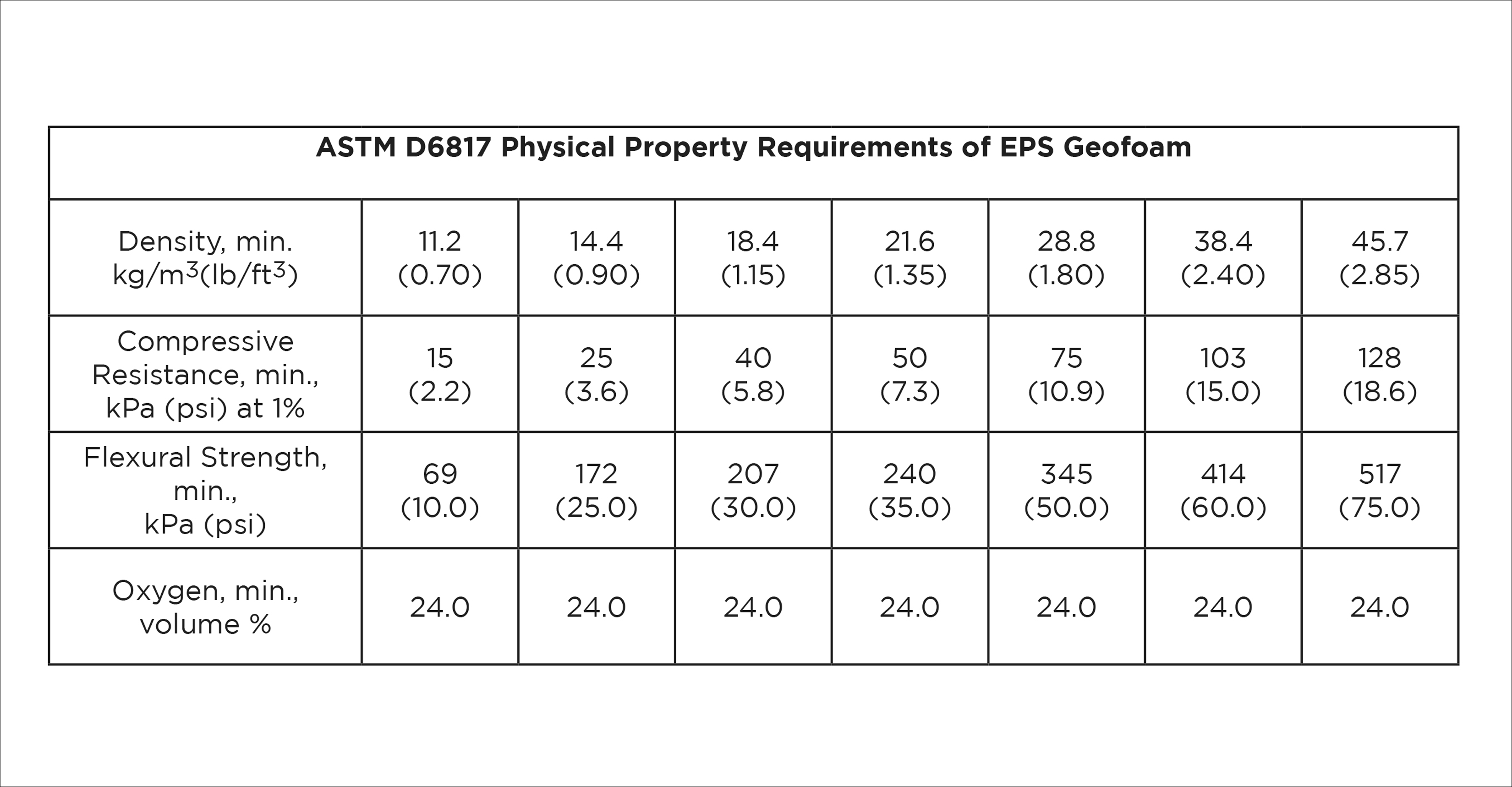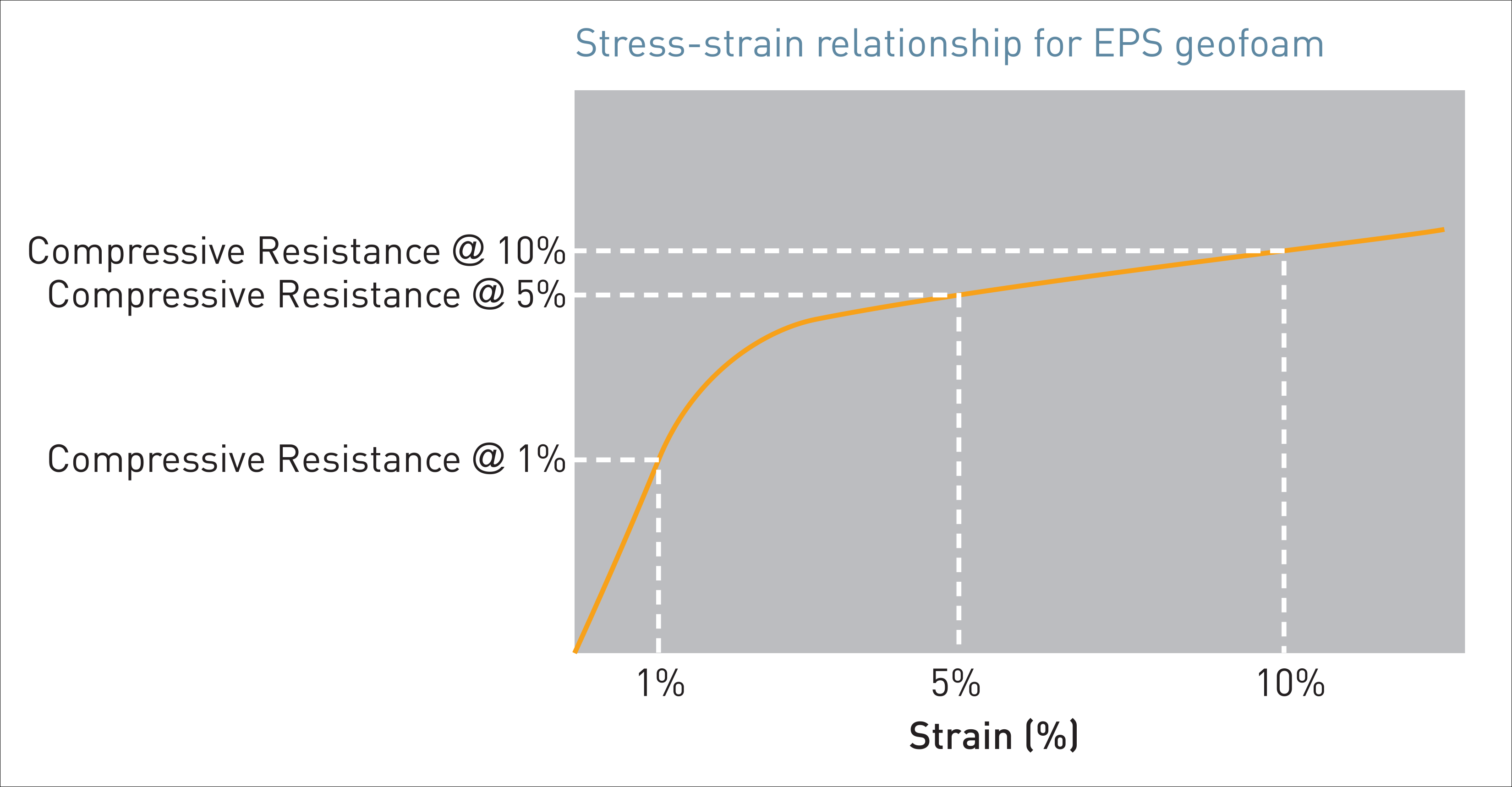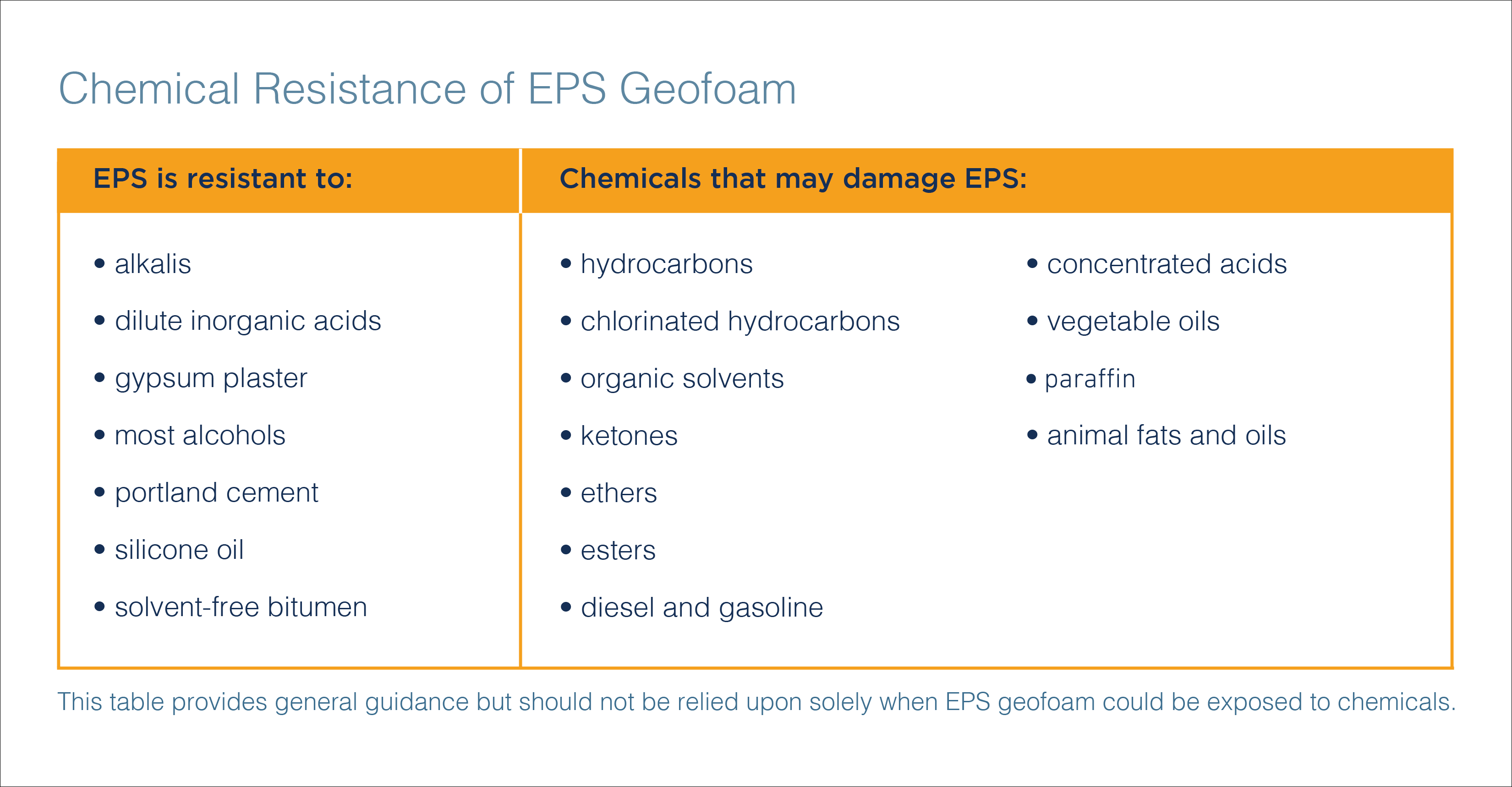GEOFOAM TYPES

EPS geofoam is available in different material types. Thorough knowledge and understanding of the type being used on a EPS geofoam project is essential.
ASTM International has three standards pertaining to EPS geofoam.
- ASTM D6817 Standard Specification for Rigid Cellular Polystyrene Geofoam provides information on the physical properties and dimensions of expanded polystyrene intended for use as geofoam.
- ASTM D7180 Standard Guide for use of Expanded Polystyrene (EPS) Geofoam in Geotechnical Projects covers design considerations for the use of EPS in geotechnical applications.
- ASTM D7557 Standard Practice for Sampling of EPS Geofoam Specimens can be used for quality assurance.
COMPRESSIVE RESISTANCE

EPS behaves as a linear elastic material up to a strain of about 1% as shown in the figure above that depict the stress-strain response of EPS. As a result, the design recommendation for EPS geofoam is to limit loading to the compressive resistance at 1% strain. The stress at a compressive strain of 1% is called the elastic limit stress and is measured in a standard rapid-loading compression test. Except for special compressible applications, higher compressive strain, e.g., 5 or 10%, is not used to estimate the EPS strength because these strains are past the yield strength of the EPS and this may lead to undesirable permanent strains.
The largest EPS project in the United States was the widening of I-15 in Salt Lake City, Utah where, from 1997 to 2001, approximately 130,800 cubic yards (100,000 cubic meters) of EPS geofoam was used to reconstruct parts of the interstate to facilitate the 2002 Winter Olympics.
In some locales, numerous pre-existing buried utility lines traversed or paralleled the interstate in the widened areas. These utilities consisted of high pressure gas lines, water mains and communication cables, all of which needed to remain in-service during construction. However, placement of conventional soil for the embankments in the widened areas would have produced as much as 3.3 to 4.9 feet (1 to 1.5 meters) of settlement, thus exceeding the strain tolerances of the buried utilities. The use of EPS geofoam in the utility areas essentially eliminated these large and damaging settlements and allowed construction to proceed rapidly without expensive interruption, replacement or relocation of the utilities.
CREEP
Creep behavior of EPS is minimal at strain levels below 1%, which is another reason for using a compressive resistance at 1% strain for design of EPS geofoam. Creep effects increase significantly at higher strains, e.g., 5 and 10%. In summary, a compressive resistance at 1% ensures adequate performance and acceptable creep behavior in EPS geofoam applications.
LOAD DISTRIBUTION
Poisson’s ratio for EPS is approximately value of 0.12 within the elastic range.
COEFFICIENT OF FRICTION
The coefficient of friction, μ, between EPS geofoam is 0.5 along molded faces. It is higher along cut faces where there is increased roughness. The coefficient of friction for a wire cut face can be assumed to be the same as a molded face or 0.5. If yellowing of the block surface occurs due to UV exposure, the block should be brushed to remove the residue and a coefficient of friction of 0.5 can be used.
R-VALUE
EPS is an efficient thermal insulator. For construction applications the polystyrene foam industry has developed test data as reported in ASTM C 578 Standard Specification for Rigid Cellular Polystyrene Thermal Insulation. Although some EPS geofoam applications may not directly utilize the insulation value of EPS geofoam, this aspect should be considered in all designs.
WATER ABSORPTION
EPS has a closed-cell structure that limits water absorption. An increase in density of EPS geofoam can be expected over time due to water absorption if the blocks are installed in a submerged application.
STABILITY
EPS is resistant to fungi and mold and offers no nutritional value to insects. Protection methods for termites include adding a termiticide during the manufacturing process or placing a physical barrier, such as a geomembrane, around the EPS geofoam.
- esters
- diesel and gasoline
- concentrated acids
- vegetable oils
- animal fats and oils
- paraffin
If using EPS geofoam in a location of contaminated soils, laboratory testing should be performed to determine the nature of the contaminants, e.g. methane, and their possible impact on the EPS geofoam.
CHEMICAL RESISTANCE

EPS is not soluble in water.
EPS is resistant, at ambient temperature, to:
- alkalis
- dilute inorganic acids
- gypsum plaster
- most alcohols
- portland cement
- silicone oil
- solvent-free bitumen
EPS can be damaged by, and should not come in contact with the materials below. Protect EPS geofoam from contact with these materials both during construction and after project completion using an appropriate hydrocarbon-resistant geomembrane or other physical barrier:
- hydrocarbons
- chlorinated hydrocarbons
- organic solvents
- ketones
- ethers
- esters
- diesel and gasoline
- concentrated acids
- vegetable oils
- animal fats and oils
- paraffin
If using EPS geofoam in a location of contaminated soils, laboratory testing should be performed to determine the nature of the contaminants, e.g. methane, and their possible impact on the EPS geofoam.